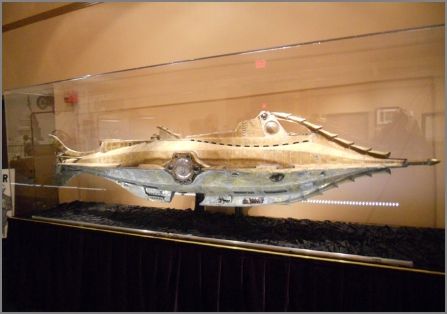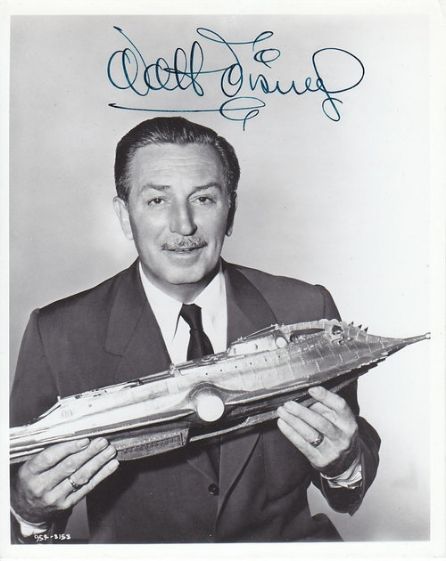A toast to the upcoming Pickwick Theatre Classic Film Series!

I have a Nemo-like desire to escape the world at the surface– the movie world where violence and noise vibrate against the walls of every multiplex across the country. Away from that I will take audiences to tranquil new worlds that broaden our horizons and reflect our humanity… I was in the chart room making final preparations for our maiden voyage when a local reporter asked me if I was certain there would be an audience for 20,000 Leagues Under the Sea. I never thought otherwise.
Walt Disney’s 20,000 Leagues Under the Sea is simply the greatest live-action film the studio ever produced. It’s the kind of moviemaking you don’t see in Hollywood these days. Today it’s all CG, and it shows. But sixty years ago, when they were making these grand films in Technicolor and CinemaScope, they built everything we see on the screen. From the sets to the models, everything was designed in such a way that the film has a distinct vision. It feels real and functional– not like an animated effect. Without question, the most striking design is that of Captain Nemo’s Nautilus. The submarine was created by art designer Harper Goff. It would become one of the most memorable models/sets in movie history. It’s influence remains such that when people think of the Jules Verne novel they immediately think of the submarine from the Disney film.
One of the original models on display…

For more photos of the Nautilus, visit the vulcaniasubmarine.com site!
The Nautilus is the inspiration for a trend in pop culture called Steampunk. This subgenre of literary fantasy has become increasingly popular with younger generations. Personally, I don’t care for the term and prefer calling it Victorian futurism, but whatever you label it, 20,000 Leagues is one of the defining films in the movement. It blends science fiction and technology with the Victorian ethos. Though the sub’s a product of the Industrial Revolution, it’s technology looks further ahead. Yet its outward design remains rooted to the late 19th century. Though based on Jules Verne, there are some significant differences with the film version of the Nautilus. Writer James Maertens describes the contrast:
[Goff’s] decision to make a baroque Nautilus that looked like the Loch Ness monster was probably a wise choice from the standpoint of the film medium because it did produce a visually fascinating design that enhanced the sense of mystery and wonder surrounding the vessel. But it is more interesting as an interpretation of the Victorian Age than as a representation of Verne’s submarine design. The Victorian Age is mythologized as a period in which wealth and technical power were combined. Acquisition, industry, and individualism all merge in the image of the high-speed machine appointed in velvet and brass. Glimpsed only fleetingly at various points during the film, Goff’s Nautilus exteriors tantalize the eye of the viewer and give the same impression of elegant power as the rich interiors with their specimen cases, draperies, and polished brass instruments. This interior opulence is certainly not a departure from the comfortable submarine-yacht designed by Verne, but the extension of the baroque to the exterior of the ship and its machinery is.”
In 20,000 Leagues, the submarine is described as being a sea monster. In order to convey those monstrous qualities, Harper Goff based the exterior of the vessel on the physical characteristics of a shark and an alligator. When the Nautilus is preparing to ram its enemies, we are reminded of a rough-skinned alligator swimming just beneath the surface toward its prey.
In addition to its visuals, 20,000 Leagues benefits from a perfect cast…

It was Harper Goff who deserves credit for the film’s wonderful designs– from every rivet of the sub’s exterior to the layout of its interior. 20,000 Leagues Under the Sea did win one of its two Oscars for Art Direction. (The other was for Best Special Effects.) Incredibly, even though the film was a result of the visionary Goff, he did not receive an Academy Award himself; he wasn’t part of the union.
Goff’s designs were groundbreaking both for the film and for the future of the genre, but the success of the film was the result of a collaborative effort. Though Walt Disney was largely credited at the time, the fact is this film came together the way it did because of director Richard Fleischer. A veteran of B films at RKO, Fleischer rose to the challenge of helming this epic. He was fortunate to be buoyed by the resources of Walt Disney and his studio. But Disney provided more than just capital. He had a clear vision of what he wanted on screen, and he knew he had to hire the most talented craftsmen in the industry to achieve that goal. The result is one of the most important films in 1950s science fiction.
NOTE: This will be our last entry on the film before we submerge on September 26. For those interested in the making of 20,000 Leagues Under the Sea, we encourage you to view the definitive “making of” documentary on the 2004 dvd release, as narrated by John Rhys-Davies.

